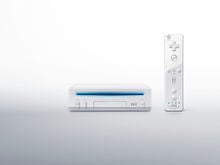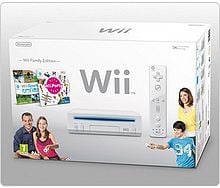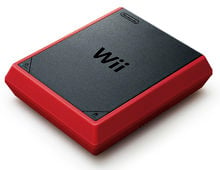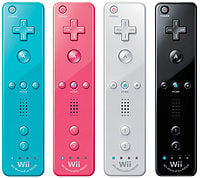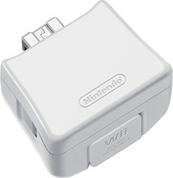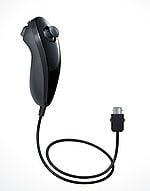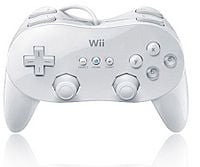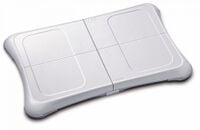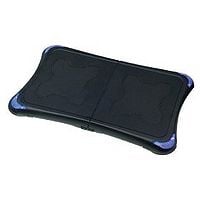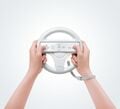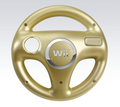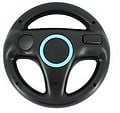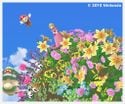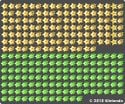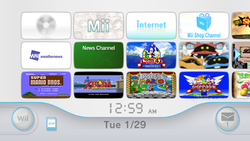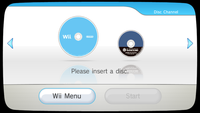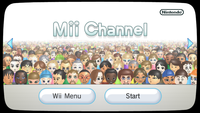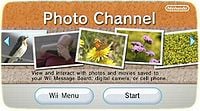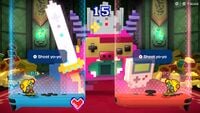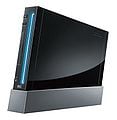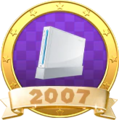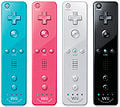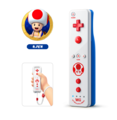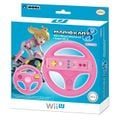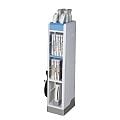Wii: Difference between revisions
No edit summary |
m (Protected "Wii": Excessive vandalism ([Edit=Allow only autoconfirmed users] (expires 12:05, November 25, 2024 (UTC)) [Move=Allow only autoconfirmed users] (expires 12:05, November 25, 2024 (UTC)))) |
||
| (305 intermediate revisions by more than 100 users not shown) | |||
| Line 1: | Line 1: | ||
{{FA}} | {{FA}} | ||
{{ | {{system infobox | ||
| | |image=[[File:Wii console.png|270px]]<br>The first version of the Wii | ||
|generation=Seventh | |generation=Seventh | ||
| | |release='''Wii''':<br>{{flag list|USA|November 19, 2006|Japan|December 2, 2006|Australia|December 7, 2006|Turkey|December 8, 2006<ref>{{cite|author=|date=December 18, 2006|url=https://www.hurriyet.com.tr/gundem/nintendo-wii-trendshow-da-5556324|title=Nintendo Wii TrendShow'da|publisher=Hürriyet|language=Turkish|archive=https://web.archive.org/web/20190318160048/https://www.hurriyet.com.tr/gundem/nintendo-wii-trendshow-da-5556324|accessdate=July 3, 2024}}</ref>|Europe|December 8, 2006<ref>{{cite|author=|date=December 18, 2006|url=https://www.derstandard.at/story/2688596/nintendo-erfolg-beschert-spielwarenspezialist-stadlbauer-umsatzplus|title=Nintendo-Erfolg beschert Spielwarenspezialist Stadlbauer Umsatzplus|publisher=Der Standard|language=German|archive=https://archive.ph/xcqEd|accessdate=June 4, 2024}}</ref>|South Africa|September 28, 2007<ref>{{cite|url=www.iol.co.za/technology/nintendo-wii-launches-in-south-africa-901795|title=Nintendo Wii launches in South Africa|publisher=IOL|language=en|date=September 28, 2007|accessdate=May 31, 2024}}</ref>|Argentina|March 26, 2008<ref>{{cite|url=https://www.canal-ar.com.ar/5642-La-Wii-inaugura-en-Argentina-la-era-de-las-consolas-de-ultima-generacion.html|title=La Wii inaugura en Argentina la era de las consolas de última generación|publisher=CanalAR|language=es|date=March 26, 2008|accessdate=July 13, 2024}}</ref>|South Korea|April 26, 2008|ROC|July 12, 2008|HK|July 23, 2011<ref>{{cite|author=Akfamilyhome|date=April 1, 2020|url=https://www.youtube.com/watch?v=IToY_73pRHU|publisher=YouTube|title=A History of Nintendo's Hong Kong Releases|language=Cantonese & English (English subtitles available)|archive=https://web.archive.org/web/20240525112253/https://www.youtube.com/watch?v=IToY_73pRHU|accessdate=June 5, 2024}}</ref>}} '''Wii Family Edition''':<br>{{flag list|USA|October 23, 2011|Europe|November 4, 2011|Australia|November 11, 2011}} '''Wii mini''':<br>{{flag list|Canada|December 7, 2012|Europe|March 15, 2013|UK|March 22, 2013|USA|November 17, 2013}} | ||
| | |discontinued='''Wii (Overall)''':<br>{{flag list|Japan|October 20, 2013<ref>{{cite|author=Bonamin, Kadu|url=www.reinodocogumelo.com/2013/10/wii-e-oficialmente-descontinuado-no.html|language=es|date=October 20, 2013|publisher=Reino do Cogumelo|accessdate=May 31, 2024}}</ref>}} '''Wii (Original)''':<br>{{flag list|USA|October 23, 2011|Europe|November 4, 2011|Australia|November 11, 2011}} '''Wii Family Edition''':<br>{{flag list|Europe|October 21, 2013<ref>{{cite|deadlink=y|archive=web.archive.org/web/20131028023021/http://www.officialnintendomagazine.co.uk/55668/wii-has-been-discontinued-in-europe-but-you-can-still-buy-a-wii-mini|title=Wii has been discontinued in Europe but you can still buy a Wii Mini|author=East, Thomas|publisher=Official Nintendo Magazine|language=en-gb|accessdate=May 31, 2024}}</ref>|Australia|October 21, 2013|USA|October 21, 2013}} '''Wii mini''':<br>2017 | ||
| | |predecessor=[[Nintendo GameCube]] | ||
| | |successor=[[Wii U]] | ||
}} | }} | ||
{{quote|Wii would like to play|Advertisement slogan for the Wii}} | |||
[[File:Wii Logo.svg|left|150px]] | |||
The '''{{wp|Wii}}''' is a home video game console created by [[Nintendo]] as the successor to the [[Nintendo GameCube]]. It was released in {{wp|North America}} on November 19, 2006, for $249.99. It was then released in {{wp|Japan}} on December 2, 2006; Oceania on December 7, 2006; and Turkey and Europe on December 8, 2006. Nintendo planned to release the system in China under the [[iQue]] name, but this ultimately did not happen. This is one of three Nintendo game consoles sold in North America before Japan, the others being the original [[Nintendo DS]] and the [[Wii U]]. Before the Wii's final name was announced on April 27, 2006, the console was codenamed "Revolution." | |||
Like the Nintendo GameCube, the Wii uses proprietary optical discs based on the DVD format. Unlike with its predecessor, however, Wii game discs are a standard 12 cm (approx. 4.72 in.) in diameter rather than 8 cm (approx. 3.15 in.), which allows them to hold more memory than the GameCube discs: up to 4.37 GB for single-layered discs, and up to 7.92 GB for dual-layered discs. However, the Wii is backwards compatible with most Nintendo GameCube games, featuring four GameCube controller ports and two GameCube memory card slots on the top of the unit, making it the first Nintendo home console to be backwards compatible with its predecessor. The Wii lacks the GameCube's support for digital audio & video output, but it retains {{wp|progressive scan}} support over component cables with compatible games (including all games related to the [[Super Mario (franchise)|''Super Mario'' franchise]] other than ''[[NBA Street V3]]'' and ''[[WarioWare, Inc.: Mega Party Game$!]]''). Under this configuration, the prompt to enable progressive scan automatically appears on startup (unlike with the GameCube, which required the player to hold {{button|GCN|B}} during boot-up). | |||
The system had integrated [[Nintendo Wi-Fi Connection]] functionality, enabling players to interact with other players around the world while playing certain games, such as ''[[Mario Kart Wii]]''. | |||
The Wii | Although the Nintendo GameCube was the first Nintendo home console since the [[Family Computer]] not to have a game from the [[Super Mario (series)|''Super Mario'' series]] at launch, the Wii is the first home console not to have a game from the ''Super Mario'' franchise as a launch title (except in Japan). The Wii's first ''Super Mario'' game is ''[[WarioWare: Smooth Moves]]'', which came out on December 2, 2006, in Japan as a launch title; January 12, 2007, in Europe; January 15, 2007, in North America; and January 25, 2007, in Oceania. The first ''Super Mario'' game for the Wii starring [[Mario]] is ''[[Super Paper Mario]]'', except in PAL regions, where ''[[Mario Strikers Charged]]'' was the game instead. | ||
In 2012, the Wii was succeeded by the Wii U, which can still play Wii games and utilizes controllers with backwards compatibility. | |||
Since May 20, 2014, | Since May 20, 2014, the Nintendo Wi-Fi Connection service has shut down, discontinuing online play for games that used it.<ref>{{cite|url=www.gamespot.com/articles/nintendo-killing-online-support-for-mario-kart-wii-super-smash-bros-brawl-in-may/1100-6417983|title=Nintendo killing online support for Mario Kart Wii, Super Smash Bros. Brawl in May|author=Makuch, Eddie|date=February 27, 2014|publisher=GameSpot|language=en|accessdate=May 31, 2024}}</ref> | ||
== | ==Revisions== | ||
===Wii Family Edition=== | ===Wii Family Edition=== | ||
[[File:New-Wiimodel.jpg|thumb|left|220px|Wii Family Edition]] | [[File:New-Wiimodel.jpg|thumb|left|220px|Wii Family Edition]] | ||
[[File:Wii-Family-Edition.jpg|thumb|220px|The box cover for Wii Family Edition]] | [[File:Wii-Family-Edition.jpg|thumb|220px|The box cover for Wii Family Edition]] | ||
The Wii Family Edition (RVL-101) was announced on August 17, 2011. This model is designed to only sit horizontally (with the buttons changed accordingly) and is incompatible with the | The Wii Family Edition (RVL-101) was announced on August 17, 2011. This model is designed to only sit horizontally (with the buttons changed accordingly) and is incompatible with the Nintendo GameCube's software and its accessories. This model was released in North America on October 23, 2011 and in Europe on November 4, 2011 in order to replace the older model and stop its production. The Wii Family Edition includes a black console, the game ''[[New Super Mario Bros. Wii]]'', and the ''[[Super Mario Galaxy Original Soundtrack]]''. The Wii Family Edition's release in North America was not originally intended to replace the older version of the Wii.<ref>{{cite|author=Brian|date=October 11, 2011|url=nintendoeverything.com/black-wii-holiday-bundle-with-new-super-mario-bros-wii-and-exclusive-music-cd-arriving-oct-23|title=Black Wii Holiday Bundle with New Super Mario Bros. Wii and Exclusive Music CD Arriving Oct. 23|publisher=Nintendo Everything|accessdate=May 31, 2024}}</ref> | ||
===Wii mini=== | ===Wii mini=== | ||
[[File:Wii-mini1.jpg|220px|thumb|Wii mini]] | [[File:Wii-mini1.jpg|220px|thumb|Wii mini]] | ||
The Wii mini (RVL-201) was announced on November 27, 2012. As its name suggests, the Wii mini is the smallest model of the Wii. Like the Wii Family Edition, it is missing some features such as the compatibility with | The Wii mini (RVL-201)<ref>{{cite|url=www.youtube.com/watch?v=a8DiepNJ82I|title=Wii mini and Nintendo Selects - Launch Trailer (Wii)|publisher=YouTube|author=Nintendo Wii UK|date=May 7, 2013|accessdate=May 31, 2024|language=en-gb}}</ref> was announced on November 27, 2012. As its name suggests, the Wii mini is the smallest model of the Wii. Like the Wii Family Edition, it is missing some features such as the compatibility with Nintendo GameCube and its accessories. It also does not have online features and several built-in channels, such as the Photo Channel and the Weather Channel, similar to the Wii Mode on the Wii U. It also can only sit horizontally. The main feature is its notable redesign. Unlike the original Wii or the Wii Family Edition which are mostly white, the Wii mini is black with a red framing. All the buttons are located on the top of the console, there are no SD card slots, and it lacks online support for Wii games. Additionally, the Wii mini has a manually operated top-loading disc drive (similar to the GameCube) instead of the slots that former models have. The console launched in Canada on December 7, 2012 for $99.99.<ref>{{cite|deadlink=y|archive=web.archive.org/web/20121129190155/http://www.nintendo.com/whatsnew/detail/ONIEEqvK1pbPyTbW2lWO6QnPUiqqvuuI|title=NINTENDO INTRODUCES NEW Wii MINI THAT'S ALL ABOUT THE GAMES|date=November 22, 2012|publisher=Nintendo of America|language=en-us|accessdate=May 31, 2024}}</ref> It was then released in Europe on March 22, 2013 at a cost of at least £79.99.<ref>{{cite|date=February 26, 2013|url=www.nintendo.com/en-gb/News/2013/February/New-Wii-mini-console-launching-on-22nd-March-727985.html|title=New Wii mini console launching on 22nd March|publisher=Nintendo UK|accessdate=May 31, 2024}}</ref> It was launched in North America on November 17, 2013 bundled with a red [[#Wii Remote Plus|Wii Remote Plus]] and a red [[#Nunchuk|Nunchuk]] for $99.99.<ref>{{cite|deadlink=y|archive=web.archive.org/web/20131104213131/http://www.nintendo.com/whatsnew/detail/a1kK4i_X_mWqfKuJPllLEHmoP_hJnJOq|title=Wii mini Offers Big Value This Holiday Season|date=November 4, 2013|publisher=Nintendo of America|language=en-us|accessdate=May 31, 2024}}</ref> The Wii mini is the third home Nintendo console since the SNES and NES to receive a redesign right after its respective successors launched though the NES 101 model launched 2 years after the SNES launched. The N64 received no redesigns of any kind, and the GameCube had a small revision that lacked the unused Serial Port 2 (though the cover still remains) and the unpopular Digital AV Out port. | ||
==Peripherals== | ==Peripherals== | ||
===Wii Remote=== | ===Wii Remote=== | ||
[[File:wiimote.jpg|thumb|150px | {{main-wiki|NWiki|Wii Remote|NintendoWiki}} | ||
The '''Wii Remote''' (also known as the "Wiimote") is the standard game controller for the Wii. It has a rectangular shape, resembling a television remote, making it unique from other consoles' controllers. It consists of several buttons (one behind ({{button|wii|B}})) and a directional pad ({{button|wii|Pad}}) as well. The Wii Remote also has a power button ({{button|wii|power}}), which can be used as a remote to either turn the Wii console on or off, rather than pressing the power button on the machine itself. | [[File:wiimote.jpg|thumb|150px|The Wii Remote (right). The standard controller for playing Wii games, along with the Nunchuk Attachment.]] | ||
The '''Wii Remote''' (also known as the "Wiimote") is the standard game controller for the Wii. It has a rectangular shape, resembling a television remote, making it unique from other consoles' controllers. It consists of several buttons (one behind ({{button|wii|B}})) and a directional pad ({{button|wii|Pad}}) as well. The Wii Remote also has a power button ({{button|wii|power}}), which can be used as a remote to either turn the Wii console on or off, rather than pressing the power button on the machine itself. When held horizontally, its button layout is similar to that of an NES controller, with the {{button|wii|1}}, {{button|wii|2}}, {{button|wii|+}} and {{button|wii|-}} buttons taking the functions of {{button|NES|B}}, {{button|NES|A}}, {{button|NES|start}} and {{button|NES|select}}, respectively; an example of this is ''[[New Super Mario Bros. Wii]]'', mimicking the control scheme of the NES ''Super Mario'' platformers with the Wii Remote held sideways. The Wii Remote can be used for NES [[Virtual Console]] games but not for SNES and N64 Virtual Console games because the Wii Remote cannot be mapped to emulate an SNES or N64 controller properly. | |||
The Wii Remote | |||
====Buttons==== | ====Buttons==== | ||
* | *{{button|wii|A}} | ||
* | *{{button|wii|B}} | ||
* | *{{button|wii|Home}} | ||
* | *{{button|wii|+}} | ||
* | *{{button|wii|-}} | ||
* | *{{button|wii|1}} | ||
* | *{{button|wii|2}} | ||
* | *{{button|wii|Pad}} | ||
* | *{{button|wii|Power}} | ||
====Wii Remote Plus==== | ====Wii Remote Plus==== | ||
| Line 201: | Line 58: | ||
The '''Wii Remote Plus''' is an upgraded version of the Wii Remote, which includes the {{wp|Wii MotionPlus}} attachment's system incorporated in the controller. The Wii Remote Plus was shown in the Nintendo's conference of September 2010, and is available in white, black, pink, cyan, and red colors. It was released in Europe on November 5, 2010 and in Japan on November 11, 2010. | The '''Wii Remote Plus''' is an upgraded version of the Wii Remote, which includes the {{wp|Wii MotionPlus}} attachment's system incorporated in the controller. The Wii Remote Plus was shown in the Nintendo's conference of September 2010, and is available in white, black, pink, cyan, and red colors. It was released in Europe on November 5, 2010 and in Japan on November 11, 2010. | ||
''[[Mario & Sonic at the Sochi 2014 Olympic Winter Games]]'' for the [[Wii U]] was the only ''Mario'' | ''[[Mario & Sonic at the Sochi 2014 Olympic Winter Games]]'' for the [[Wii U]] was the only game of the ''Super Mario'' franchise to ever use the Wii MotionPlus. | ||
{{br}} | {{br}} | ||
===Nunchuk=== | ===Nunchuk=== | ||
{{main-wiki|NWiki|Nunchuk|NintendoWiki}} | |||
[[File:Black Nunchuk.jpg|150px|thumb|A Black Nunchuk]] | [[File:Black Nunchuk.jpg|150px|thumb|A Black Nunchuk]] | ||
The '''Nunchuk''' is the main attachment to the Wii Remote. Upon buying a Wii, one Wii Remote and one Nunchuk are included. It consists of two buttons ({{button|wii|C}} and {{button|wii|Z}}) along with an analog stick ({{button|wii|Stick}}). Like the Wii Remote, the Nunchuk also includes motion sensors. It is named as such because of the similarity in appearance to {{wp|nunchaku}} when being used together with the Wii Remote. | The '''Nunchuk''' is the main attachment to the Wii Remote. Upon buying a Wii, one Wii Remote and one Nunchuk are included. It consists of two buttons ({{button|wii|C}} and {{button|wii|Z}}) along with an analog stick ({{button|wii|Stick}}). Like the Wii Remote, the Nunchuk also includes motion sensors. It is named as such because of the similarity in appearance to {{wp|nunchaku}} when being used together with the Wii Remote. | ||
| Line 210: | Line 68: | ||
;Names in other languages | ;Names in other languages | ||
{{foreign names | {{foreign names | ||
| | |Jap=ヌンチャク | ||
| | |JapR=nunchaku | ||
|JapM=Nunchuk | |||
|ChiS=拿趣酷<ref>From the unused Simplified Chinese Wii System Menu text</ref> | |||
|ChiSR=Náqùkù | |||
|ChiSM=Transliteration of Nunchuk, also means "To hold Fun and Cool" | |||
|ChiT=雙截棍控制器<ref>{{cite|url=web.archive.org/web/20130119145526/http://www.nintendo.com.hk/wii/wii_console.htm|title=Wii主機|publisher=Nintendo HK|language=zh-hant|accessdate=May 31, 2024}}</ref> | |||
|ChiTR=Shuāngjiégùn Kòngzhìqì | |||
|ChiTM=Nunchuk Controller | |||
}} | }} | ||
| Line 222: | Line 87: | ||
===Classic Controller=== | ===Classic Controller=== | ||
{{main-wiki|NWiki|Classic Controller|NintendoWiki}} | |||
[[File:wiiclassic.jpg|thumb|The Classic Controller, used for playing classic [[Nintendo]] games on the Wii]] | [[File:wiiclassic.jpg|thumb|The Classic Controller, used for playing classic [[Nintendo]] games on the Wii]] | ||
The '''Classic Controller''' is an extension or accessory for the Wii Remote. Besides the two analog sticks, the button layout resembles that of the [[Super Nintendo Entertainment System]]'s controller. The Classic Controller must be used to play | The '''Classic Controller''' is an extension or accessory for the Wii Remote. Besides the two analog sticks, the button layout resembles that of the [[Super Nintendo Entertainment System]]'s controller. The Classic Controller must be used to play SNES and N64 Virtual Console games such as ''[[Super Mario World]]'' and ''[[Super Mario 64]]''. Some Wii games, such as ''[[Super Smash Bros. Brawl]]'' and ''[[Mario Kart Wii]]'' are compatible as well. | ||
Just as the [[Nintendo GameCube]] was codenamed Dolphin and the Wii was codenamed Revolution, the Classic Controller was codenamed '''Shell'''.<ref>{{cite|author=Gibson, Ellie|date=September 19, 2005|url=www.eurogamer.net/i-jimmerrick-revcon|title=Jim Merrick Takes Control|publisher=Eurogamer|language=en|accessdate=May 31, 2024}}</ref> | |||
{{br}} | |||
====Classic Controller Pro==== | ====Classic Controller Pro==== | ||
{{main-wiki|NWiki|Classic Controller Pro|NintendoWiki}} | |||
{{multiframe | {{multiframe | ||
|[[File:Classic Controller Wii PRO.jpg|200px]]<br>[[File:Black Controller Pro.jpg|200px]] | |[[File:Classic Controller Wii PRO.jpg|200px]]<br>[[File:Black Controller Pro.jpg|200px]] | ||
| Line 238: | Line 101: | ||
|align=right | |align=right | ||
}} | }} | ||
The '''Classic Controller Pro''' is an enhanced version of the Classic Controller, listed on Nintendo's Japanese website on February 26, 2009. This revision features the {{button|wii|ZL}} and {{button|wii|ZR}} buttons as full-fledged shoulder buttons, like the {{button|gcn|L}} and {{button|gcn|R}} buttons on the Nintendo GameCube controller, as well as added controller grips. However, the {{button|wii|L}} and {{button|wii|R}} buttons are no longer pressure-sensitive, unlike with the original Classic Controller. The controller is also slightly bigger than its old revision. The Classic Controller Pro was released in Japan on August 1, 2009 in both black and white colors. It was subsequently released in Europe and North America in November 2009<ref>{{cite|author=Siliconera Staff|date=October 20, 2009|url=www.siliconera.com/black-wii-bundle-classic-controller-pro-dated-for-europe|title=Black Wii Bundle, Classic Controller Pro Dated For Europe|publisher=Siliconera|accessdate=May 31, 2024}}</ref> and April 2010<ref>{{cite|author=Davies, Chris|date=January 25, 2010|url=www.slashgear.com/wii-classic-controller-pro-hits-us-from-april-2010-2571200|title=Wii Classic Controller Pro Hits US From April 2010|publisher=SlashGear|accessdate=May 31, 2024}}</ref> respectively (though only in black in Europe). | |||
====Buttons and Sticks==== | |||
*a ({{button|wii|cca}}) | *a ({{button|wii|cca}}) | ||
*b ({{button|wii|ccb}}) | *b ({{button|wii|ccb}}) | ||
| Line 254: | Line 120: | ||
===Wii Balance Board=== | ===Wii Balance Board=== | ||
{{main-wiki|NWiki|Wii Balance Board|NintendoWiki}} | |||
[[File:BalanceBoard.jpg|thumb|left|The Wii Balance Board]] | [[File:BalanceBoard.jpg|thumb|left|The Wii Balance Board]] | ||
[[File:Black Wii Balance Board.jpg|thumb|A Black Wii Balance Board]] | [[File:Black Wii Balance Board.jpg|thumb|A Black Wii Balance Board]] | ||
The '''Wii Balance Board''' is a controller for the Wii that is used for various games, most prominently in '' | The '''Wii Balance Board''' is a controller for the Wii that is used for various games, most prominently in ''[[miiwiki:Wii Fit|Wii Fit]]''. The Balance Board, unlike the Nunchuk or Classic Controller, acts as a separate controller and does not need to be connected to the Wii Remote. The Board is capable of measuring the weight, balance, and movement of the player that is using it. The only ''Super Mario'' game that ever used the Wii Balance Board was ''[[Mario & Sonic at the Olympic Winter Games (Wii)|Mario & Sonic at the Olympic Winter Games]]''. A [[Costume Mario|costume]] of a Wii Balance Board appears in ''[[Super Mario Maker]]''. | ||
{{br}} | {{br}} | ||
| Line 262: | Line 129: | ||
[[File:Wii wheel.png|thumb|190px|The Wii Wheel, with the [[#Wii Remote|Wii Remote]] in it]] | [[File:Wii wheel.png|thumb|190px|The Wii Wheel, with the [[#Wii Remote|Wii Remote]] in it]] | ||
The '''Wii Wheel''' is an accessory for the Wii that resembles a car steering wheel and is designed for ''[[Mario Kart Wii]]''. One Wii Wheel is packaged with ''Mario Kart Wii'', but more can be bought separately. The Wii Wheel is used to assist in holding the remote and may help players control the game more easily. The Wii Wheel does not connect to the Wii or Remote in any way and is used to only hold the Remote. Because of this, if only the Wii Remote is held sideways (without the Wheel) on ''Mario Kart Wii'', it still shows that a wheel is being used. | The '''Wii Wheel''' is an accessory for the Wii that resembles a car steering wheel and is designed for ''[[Mario Kart Wii]]''. One Wii Wheel is packaged with ''Mario Kart Wii'', but more can be bought separately. The Wii Wheel is used to assist in holding the remote and may help players control the game more easily. The Wii Wheel does not connect to the Wii or Remote in any way and is used to only hold the Remote. Because of this, if only the Wii Remote is held sideways (without the Wheel) on ''Mario Kart Wii'', it still shows that a wheel is being used. | ||
====Prototypes==== | ====Prototypes==== | ||
The first prototype was made when Nintendo was trying to discover the best position to put the Wii Remote. Since Nintendo could not decide where the {{button|wii|B}} button would be used, there was nothing on the back. For the second prototype, Nintendo examined real go-kart wheels, and the company discovered that they are usually more square than round. The third prototype was the basis for the final Wii Wheel. This prototype had a window for using the Wii Menu and a hole for the {{button|wii|B}} button. The fourth prototype had a {{button|wii|B}} button in the Wii Wheel itself, so a child’s finger could reach. Finally, the fifth prototype had a two-tone color scheme. A pure white color scheme was eventually decided on to match the Wii Zapper and the Wii Balance Board. Kenichiro Ashida made two Wii Wheels to show at the "Iwata Asks" interview on ''Mario Kart Wii''. | The first prototype was made when Nintendo was trying to discover the best position to put the Wii Remote. Since Nintendo could not decide where the {{button|wii|B}} button would be used, there was nothing on the back. For the second prototype, Nintendo examined real go-kart wheels, and the company discovered that they are usually more square than round. The third prototype was the basis for the final Wii Wheel. This prototype had a window for using the Wii Menu and a hole for the {{button|wii|B}} button. The fourth prototype had a {{button|wii|B}} button in the Wii Wheel itself, so a child’s finger could reach. Finally, the fifth prototype had a two-tone color scheme. A pure white color scheme was eventually decided on to match the Wii Zapper and the Wii Balance Board. Kenichiro Ashida made two Wii Wheels to show at the "Iwata Asks" interview on ''Mario Kart Wii''. | ||
=====Gallery | =====Gallery===== | ||
<gallery> | <gallery> | ||
WiiWheelBack.jpg|Back of Wii Wheel | |||
WiiWheelHeld.jpg|Wii Wheel being held by a pair of hands | |||
Wiiwheelprototype1.jpg|First prototype | Wiiwheelprototype1.jpg|First prototype | ||
Wiiwheelprototype2.jpg|Second prototype | Wiiwheelprototype2.jpg|Second prototype | ||
| Line 277: | Line 144: | ||
Specialwiiwheel1.jpg|Gold | Specialwiiwheel1.jpg|Gold | ||
SMKWii.png|Gold | SMKWii.png|Gold | ||
Golden Wii Wheel.jpg|Gold with box | |||
Black Wii Wheel.jpg|Black | Black Wii Wheel.jpg|Black | ||
</gallery> | </gallery> | ||
{{br}} | {{br}} | ||
The Gold Wheel was available only as a redeemable prize from [[Club Nintendo (rewards program)|Club Nintendo]] in Australia, Europe, Japan, and North America. | |||
===Nintendo GameCube Controller=== | |||
{{main|Nintendo GameCube#Nintendo GameCube Controller}} | |||
The [[Nintendo GameCube#Nintendo GameCube Controller|Nintendo GameCube Controller]] can also be used for certain games such as ''Mario Kart Wii'' and Virtual Console games, and as an alternative to the Wii Classic Controller (and the Pro version). | |||
===SD cards=== | |||
[[File:SecureDigitalCard Wikimedia Commons.svg|75px|right]] | |||
An '''SD card''' is a standardized memory card format supported by the Wii, which can be used to store WiiWare and Virtual Console games, some games and channels' photos, and to keep backups of certain games' save files. Far from all games allow the internal memory's save files to be moved to SD cards, and ones that do not support it include ''[[Mario Kart Wii]]'', ''[[Super Smash Bros. Brawl]]'' and all GameCube games. Among ''Super Mario'' games that do support taking backups of save files, the files are typically small and around one block (128 KB), with a handful of Mario games at two blocks (256 KB) such as ''[[Mario Super Sluggers]]'' and ''[[Donkey Kong Country Returns]]''. | |||
At launch, the Wii only supported the initial industry standard that had a cap at 2 GB. The Wii System Menu 4.0 update in March 2009 added support for SDHC cards up to 32 GB, but it did not have retroactive effect for games released before then. The 4.0 update also added a designated SD card game menu that could launch WiiWare and Virtual Console games directly from the SD card, including from write-protected SD cards. | |||
By inserting the Wii's SD card into a PC that has an SD card reader, JPEG images can be added to the SD card which can then be inserted back into the Wii to make them able to view in Photo Channel. | |||
The Wii retained the GameCube's use of blocks as a non-standard data measurement unit, but the Wii's blocks are 128 KB, while those on GameCube were merely 8 KB. At full capacity, a 32 GB SC card would be converted internally by the Wii as 262,144 blocks. | |||
====Channel and WiiWare game sizes==== | |||
Below is a list of the file sizes of Wii channels and [[WiiWare]] games that can be copied in their entirety to an SD card normally in the Data Management settings. | |||
{|class="wikitable sortable" style="text-align:center" | |||
|- | |||
!Game | |||
!Blocks | |||
!Megabytes (MB) | |||
|- | |||
|''[[Mario Kart Channel]]'' | |||
|86 | |||
|11.0 | |||
|- | |||
|''[[Dr. Mario Online Rx]]'' | |||
|103 | |||
|12.8 | |||
|- | |||
|''[[WarioWare: D.I.Y. Showcase]] | |||
|50 | |||
|6.2 | |||
|} | |||
==Wii Message Board== | |||
{{multiframe|[[File:MarioPeachSMG.png|100px]][[File:LuigiRosalinaSMG.png|100px]]<br>[[File:SMG2Picture1.jpg|125px]][[File:SMG2Picture2.jpg|125px]][[File:MKWEND2.png|125px]]|Pictures to be sent to the Wii Message Board|align=right}} | |||
The Wii Message Board, powered by [[nwiki:WiiConnect24|WiiConnect24]], was a messaging system that users could use to send messages to other Wii users prior to its discontinuation. The user could either register a different Wii Friend Code separate from the games that use Friend Code exchange or send a friend request to someone that uses a third-party e-mail service, such as {{wp|Outlook.com|Hotmail}} or {{wp|Gmail}}. The service was discontinued on June 27, 2013.<ref>{{cite|deadlink=y|archive=web.archive.org/web/20130414035826/http://www.nintendo.com/whatsnew/detail/tiQImp7Oi97LiEyVqwDqL-eDnX6u9qjk|title=Shutdown of Wii Channels|date=April 12, 2013|publisher=Nintendo of America|language=en-us|accessdate=May 31, 2024}}</ref> ''[[Super Mario Galaxy]]'', ''[[Super Mario Galaxy 2]]'', and ''[[Mario Kart Wii]]'' use this feature separately from WiiConnect24. | |||
In ''Super Mario Galaxy'', the [[Mailtoad]] will send images to the Wii Message Board if both [[Mario]] and [[Luigi]] talk to him in the mission [[The Star Festival]]. | |||
In ''Mario Kart Wii'', a picture of the playable Mario, Peach, and the player's [[Mii]] before the player gets all gold on all courses or a picture of all the playable characters with the player's Mii after the player gets all gold is sent to the Wii Message Board upon the player finishing the credits. | |||
In ''Super Mario Galaxy 2'', a picture is obtained when the player beats Bowser one time and another once the player [[completion|beats the game 100%]]. | |||
{{br}} | |||
==Wii Channels related to the ''Super Mario'' franchise== | |||
{{main-wiki|NWiki|Wii Channel|NintendoWiki}} | |||
[[File:Wii Systemmenu.png|thumb|250px|The Wii Menu, up to August 2007]] | |||
The Wii is Nintendo's first home console with a wide variety of built-in software. '''Wii Channels''' are channels accessible from the Wii Menu. There are four pages of channels; each page can hold twelve channels, meaning there can be in total 48 channels in a typical Wii Menu. The channels can be moved around on the Wii Menu by holding {{button|wii|A}} + {{button|wii|B}} and dragging them. | |||
===Disc Channel=== | |||
{{main-wiki|NWiki|Disc Channel|NintendoWiki}} | |||
[[File:Wii Discchannel.png|thumb|left|The Disc Channel in the original Wii model, when no disc is inserted]] | |||
The Disc Channel is the channel in which game discs are loaded and played. It is the first channel on the menu and cannot be moved. It displays a preview icon of the game currently inside the disc slot and plays a unique jingle when selected; if a [[Nintendo GameCube]] game is in the slot, it does not have a preview and only displays the Nintendo GameCube logo and plays the default GameCube startup jingle when selected. When a disc is loading, as seen in the picture, the Nintendo GameCube and Wii discs are shown spinning, and whichever disc type that was inserted will lower into an opening denoting a disc reader. | |||
{{br}} | |||
;Names in other languages | |||
{{foreign names | |||
|Spa=Canal Disco | |||
|SpaM=Disc Channel | |||
}} | |||
===Mii Channel=== | |||
{{main-wiki|MiiWiki|Mii Channel}} | |||
[[File:Wii Miichannel.png|thumb|left|The Mii Channel]] | |||
[[File:MiiChannel2.jpg|thumb|The Mii Plaza inside the Mii Channel, with various [[Mii]]s]] | |||
[[Mii]]s are customized characters that can be used in various Wii games, including games such as ''[[Mario Party 8]]'', ''[[Mario Kart Wii]]'' and the ''Mario & Sonic'' games. A maximum of 100 Miis can be created and saved in the Mii Channel in the Mii Plaza. By using WiiConnect24, friends' Miis can be displayed in the Mii Parade; a parade of various Miis saved on friends' Mii Channels. Miis can also be stored in [[#Wii Remote|Wii Remotes]], with a maximum capacity of 10. These Miis can then be transported to a different Wii by using the Wii Remote on a different Wii and then loading the Miis from the controller. The option to transfer Miis to a supporting [[Nintendo 3DS]] system can be unlocked by pressing {{button|wii|A}}, {{button|wii|B}}, {{button|wii|1}}, and {{button|wii|2}} in that order.<ref>{{cite|url=www.gameyum.com/wii-gaming/120532-how-to-copy-your-miis-from-your-nintendo-wii-to-your-3ds|title=How to Transfer Miis to 3DS (or Transfer Miis from the Wii to the 3DS)|publisher=GameYum|accessdate=May 31, 2024}}</ref> | |||
{{br}} | |||
;Names in other languages | |||
{{foreign names | |||
|Spa=Canal Mii | |||
|SpaM=Mii Channel | |||
}} | |||
===Photo Channel=== | |||
{{main-wiki|NWiki|Photo Channel|NintendoWiki}} | |||
[[File:PhotoChannel.jpg|thumb|The Photo Channel]] | |||
The Photo Channel allows the user to save, view, and apply various effects to photos and videos from either an {{wp|SD card}} or the Wii Message Board. Effects include doodling, stamping, and altering brightness settings. Photos can also be turned into sliding puzzles. When the game ''[[Mario Kart Wii]]'' is beaten, the player is given the choice whether or not to send the winning photo to the Message Board. There are several other games that behave like this such as ''[[Super Mario Galaxy]]'' and ''[[Super Mario Galaxy 2]]''. | |||
;Names in other languages | |||
{{foreign names | |||
|Spa=Canal Fotos | |||
|SpaM=Photos Channel | |||
}} | |||
===Wii Shop Channel=== | |||
{{main-wiki|NWiki|Wii Shop Channel|NintendoWiki}} | |||
The Wii Shop Channel was a virtual shopping network where users could purchase and download [[WiiWare]] and [[Virtual Console]] games in exchange for the required amount of Wii Points. The Virtual Console allowed players to download games that were originally released on the [[Nintendo Entertainment System|NES]], [[Super Nintendo Entertainment System|SNES]], and [[Nintendo 64]], and play them on their Wii console. They could also buy special games called [[WiiWare]] which can be purchased only on the Wii Shop Channel itself. Rather than using money to directly buy the games, a credit currency called [[nwiki:Wii Points|Wii Points]] is used. Wii Points can be earned by either purchasing them with a credit card or redeeming a Wii Point Card. Other free-of-charge channels, such as the Nintendo Channel and Internet Channel, were also available for download at the Wii Shop Channel. | |||
When downloading a game or channel from the Wii Shop Channel, one would be asked to verify their purchase (if Wii Points are needed), after which they will be presented with the download screen. The download screen consisted of an 8-bit [[Mario]] character continuously running across the bottom of the screen and collecting [[coin]]s as they moved towards him. The progress of the download was indicated by three [[Brick Block]]s floating above 8-bit Mario's head, which he will jump up and hit as he runs across the screen. Every time the download progresses 33%, a Brick Block would have turned into an [[Empty Block]]. The final Brick Block represents the point at which the download has reached 99%. When 8-bit Mario reaches this block, he would jump and hit it multiple times and continue to do so until the download was complete. | |||
Sometimes, [[Fire Mario]] would have appeared instead of regular Mario. When this happens, one could have made Fire Mario shoot fireballs while the download was in progress by pressing the {{button|wii|A}} button. Occasionally, 8-bit [[Luigi]] appears in place of 8-bit Mario, or both 8-bit Mario and 8-bit Luigi would swim across the screen instead of running across it. There is a total of six different animations one may have experienced while downloading software from the Wii Shop Channel, some of which appear more often than others. | |||
The Wii Shop Channel service was discontinued on January 30, 2019, though the ability to add Wii Points was discontinued on March 26, 2018. Between these times, users would have still been able to browse and download purchased software.<ref>{{cite|author=Romano, Sal|date=September 29, 2017|url=www.gematsu.com/2017/09/wii-shop-channel-end-service-january-31-2019|title=Wii Shop Channel to end service on January 31, 2019|publisher=Gematsu|accessdate=May 31, 2024}}</ref> | |||
The [[Nintendo 3DS]], [[Wii U]], and [[Nintendo Switch]] have a similar online shop called the [[Nintendo eShop]]. The [[Nintendo DSi]] also had an online shop (simply called the Nintendo DSi Shop), but that shop was also discontinued. | |||
<gallery> | |||
Wii Shopchannel.png|The Wii Shop Channel preview | |||
ShopChannel2.jpg|Early Wii Shop Channel menu | |||
Wii Shop Channel menu.png|Most recent Wii Shop Channel menu before the service ended | |||
Wii Shop Channel download.png|8-bit [[Mario]] appearing on the Wii Shop Channel download screen | |||
</gallery> | |||
;Names in other languages | |||
{{foreign names | |||
|Spa=Canal Tienda Wii | |||
|SpaM=Wii Shop Channel | |||
}} | |||
===Forecast Channel=== | |||
{{main-wiki|NWiki|Forecast Channel|NintendoWiki}} | |||
[[File:ForecastChannel.jpg|thumb|The Forecast Channel]] | |||
The Forecast Channel was added on December 19, 2006, about one month after the console itself was released. The channel preview displayed the local weather of where the user is located. Some games, including ''[[Mario & Sonic at the Olympic Winter Games]]'', have an option that allowed the game to draw information from the Forecast Channel and use that weather as the weather conditions in the game. | |||
;Names in other languages | |||
{{foreign names | |||
|Spa=Canal Tiempo | |||
|SpaM=Weather Channel | |||
}} | |||
===Virtual Console Channels=== | |||
Virtual Console channels are downloadable games that can be purchased from the Wii Shop Channel at varying prices. These various channels allow users to play classic [[Nintendo Entertainment System|NES]], [[Super Nintendo Entertainment System|SNES]], and [[Nintendo 64]] games such as ''[[Donkey Kong (game)|Donkey Kong]]'', ''[[Super Mario World]]'', and ''[[Super Mario 64]]''. The Virtual Console also supports selected games from the Sega Genesis/Mega Drive and the TurboGrafx-16 systems. Although some games can be played using the Wii Remote, others require the use of either a [[Nintendo GameCube]] controller or a Classic Controller. | |||
===Nintendo Channel=== | |||
{{rewrite-expand|section=y|Which ''Super Mario'' demos, to be exact?}} | |||
{{main-wiki|NWiki|Nintendo Channel|NintendoWiki}} | |||
[[File:Wii Nintendochannel.png|thumb|left|The Nintendo Channel]] | |||
The Nintendo Channel was released in November 2007 in Japan and May 7, 2008 in America. The Nintendo Channel allows players to view video features and information on upcoming games, including those in the ''Super Mario'' franchise. After downloading, the demos will remain in the DS's memory until the system is switched off. Users could also recommend games that they have played for more than an hour by filling out a brief survey that asks which demographic it is best suited for. Other features include Nintendo DS and Wii demonstration videos, with gameplay videos of newly released Virtual Console and future WiiWare titles. If a game sparks the player's interest, they will be quickly directed to one of several popular purchasing sites via the Internet Channel. The Nintendo Channel was removed along with WiiConnect24. | |||
{{br}} | |||
;Names in other languages | |||
{{foreign names | |||
|Spa=Canal Nintendo | |||
|SpaM=Nintendo Channel | |||
}} | |||
===Mario Kart Channel=== | |||
[[File:Mario Kart Channel.png|thumb|The Mario Kart Channel]] | |||
The Mario Kart Channel is a channel specifically made to work with ''[[Mario Kart Wii]]''. The channel requires 86 blocks (11.0 MB) to be installed. Once installed from the game, this channel can be used to register friends, race ghosts, race friends or random users, enter tournaments, and get updates from Nintendo or other players. The [[Nintendo 3DS]] game ''[[Mario Kart 7]]'' also includes Mario Kart Channel as an in-game mode, though it has different features. | |||
===Wii | ;Names in other languages | ||
{{foreign names | |||
|ChiT=瑪利歐賽車頻道<ref>{{cite|language=zh-hant|url=www.nintendo.tw/mariokartwii/game_mode/index_04.html|title=瑪利歐賽車 Wii (日文版):遊戯模式 - 台灣任天堂網站|publisher=Nintendo Taiwan|accessdate=May 31, 2024}}</ref> | |||
|ChiTR=Mǎlì'ōu Sàichē Píndào | |||
|ChiTM=Mario Kart Channel | |||
|Spa=Canal Mario Kart | |||
|SpaM=Mario Kart Channel | |||
}} | |||
== | ==WiiWare channels== | ||
===''WarioWare: Smooth Moves''=== | {{main|WiiWare}} | ||
The Wii Remote (known as the [[Form Baton]] in the game) appears in several microgames in | [[File:WiiWare.svg|thumb|left|The WiiWare logo]] | ||
WiiWare was a feature that was launched for the Wii Shop Channel in 2008, which consisted of smaller-sized games that could be downloaded onto the Wii or SD card memory using [[Virtual Console#Wii Points|Wii Point]]s, which would then appear on the Wii Menu as individual channels. Some ''Super Mario'' WiiWare titles included ''[[Dr. Mario Online Rx]]'' and ''[[WarioWare: D.I.Y. Showcase]]''. Some WiiWare titles used Nintendo Wi-Fi connection, allowing the player to play with other Wii players over the internet. Others included Mii compatibility, allowing players to play the game as their own Mii created in the Mii Channel. Also, some games allowed the player to transfer and use the data from a [[Nintendo DS]] game, such as ''WarioWare D.I.Y. Showcase''. | |||
{{br}} | |||
==Virtual Console== | |||
{{main|Virtual Console}} | |||
In addition to being backwards-compatible with [[Nintendo GameCube]] games, the Wii Shop Channel has a section called [[Virtual Console]], which allows the players to download emulated versions of games from the [[Nintendo 64]] era and before to play on the Wii. Many of them were ''Super Mario'' games. Each downloaded game costs between 500 and 1000 [[Virtual Console#Wii Points|Wii Points]]. The games are priced based on the system they were released on, with imported games generally costing an additional 100 points, or 200 points for Nintendo 64 games. | |||
The Virtual Console versions of games are primarily straight emulations with no major changes or additions, although a few games such as ''[[Super Mario RPG: Legend of the Seven Stars]]'' and ''[[Mario Kart 64]]'' are edited to remove potentially seizure-inducing or copyright-infringing graphics. Additionally, Nintendo 64 games do not support the Rumble Pak or Transfer Pak accessories, meaning parts of games that use these features may not function completely in the Virtual Console version. | |||
The Wii Virtual Console is also accessible from the [[Wii U]] inside Wii mode, independently from the Wii U's own Virtual Console. | |||
{{br}} | |||
==Appearances in the ''Super Mario'' franchise== | |||
===''WarioWare'' series=== | |||
====''WarioWare: Smooth Moves''==== | |||
The Wii Remote (known as the [[Form Baton]] in the game) appears in several microgames in ''[[WarioWare: Smooth Moves]]'', as well as an object in the game's story. The Nunchuk (known as the [[Balance Stone]] in the game) appears in [[Orbulon]]'s microgames and story. | |||
====''WarioWare: D.I.Y.''==== | |||
In the intro cutscene of ''[[WarioWare: D.I.Y.]]'', [[Dr. Crygor]] is playing a Wii game, as the console is seen near the TV. | |||
====''WarioWare Gold''==== | |||
The Wii appears as a collectible Nintendo [[List of souvenirs in WarioWare Gold|souvenir]] in ''[[WarioWare Gold]]''. | |||
====''WarioWare: Get It Together!''==== | |||
[[File:WWGIT Nintendo Classics Boss.jpg|thumb|The Boss Stage]] | |||
In [[9-Volt]]'s Nintendo Classics level in ''[[WarioWare: Get It Together!]]'', the boss that appears in the intermission before the boss microgame wields a Wii Remote as a sword. | |||
===''Super Paper Mario''=== | ===''Super Paper Mario''=== | ||
When the player enters [[Francis]]'s room in [[Fort Francis]] and [[flip]]s, they can see a large TV and a Wii with a Wii Remote. Also, when the player fights [[Fracktail]], Fracktail starts downloading information about Mario. While he is doing so, his eyes turn into the circle that appears when the Wii Shop Channel is loading from the Wii Menu. | When the player enters [[Francis]]'s room in [[Fort Francis]] and [[flip]]s, they can see a large TV and a Wii with a Wii Remote. Also, when the player fights [[Fracktail]], Fracktail starts downloading information about Mario. While he is doing so, his eyes turn into the circle that appears when the Wii Shop Channel is loading from the Wii Menu. | ||
===''Mario Kart Wii''=== | ===''Mario Kart Wii''=== | ||
In the cutscene before the file selection screen, Mario and Luigi use Wii Wheels to race and drive in invisible karts. Peach joins them with her own Wii Wheel, and their karts become visible shortly afterwards, with their Wii Wheels becoming | In the cutscene before the file selection screen, Mario and Luigi use Wii Wheels to race and drive in invisible karts. Peach joins them with her own Wii Wheel, and their karts become visible shortly afterwards, with their Wii Wheels becoming their karts wheels. | ||
===''Mario Super Sluggers''=== | ===''Mario Super Sluggers''=== | ||
[[File:Daisy-mss-intro-1.png|thumb|Daisy holding a Wii Remote in the ''[[Mario Super Sluggers]]'' opening]] | [[File:Daisy-mss-intro-1.png|thumb|Daisy holding a Wii Remote in the ''[[Mario Super Sluggers]]'' opening cinematic]] | ||
In the opening | In the opening cinematic of ''Mario Super Sluggers'', [[Princess Daisy|Daisy]], [[Luigi]], and [[Mario]] carry Wii Remotes with them as they run towards Mario Stadium. When Daisy brandishes the remote on the mound, it transforms into a baseball bat, and Luigi encounters the same method moments later. When Mario brandishes the remote, it transforms into a baseball. | ||
===''Yoshi's Woolly World''=== | ===''Yoshi's Woolly World''=== | ||
| Line 310: | Line 346: | ||
===''Super Smash Bros.'' series=== | ===''Super Smash Bros.'' series=== | ||
Starting with ''[[Super Smash Bros. for Nintendo 3DS]]'', [[Wii Fit Trainer]]'s entrance animation has them balancing on a Wii Balance Board before stepping off of it. In addition, the Wii Balance Board appears as a [[Trophy (Super Smash Bros. series)|trophy]] in ''[[Super Smash Bros. for Wii U]]''. The Wii Balance Board also appears as a | Starting with ''[[Super Smash Bros. for Nintendo 3DS]]'', [[Wii Fit Trainer]]'s entrance animation has them balancing on a Wii Balance Board before stepping off of it. In addition, the Wii Balance Board appears as a [[Trophy (Super Smash Bros. series)|trophy]] in ''[[Super Smash Bros. for Wii U]]''. The Wii Balance Board also appears as a master [[Spirit (Super Smash Bros. Ultimate)|spirit]] in ''[[Super Smash Bros. Ultimate]]'', teaching the Lightweight Style to other spirits (said style increases move speed and jump height, but decreases offense, defense, and weight). The Wii Balance Board spirit battle is against Wii Fit Trainer on the [[Wii Fit Studio]] stage with the music "Wii Fit Plus Medley" (from ''{{wp|Wii Fit Plus}}'') playing, with all fighters having increased movement speed and being easier to launch after some time. | ||
===''Mario & Luigi: Superstar Saga + Bowser's Minions''=== | ===''Mario & Luigi: Superstar Saga + Bowser's Minions''=== | ||
In ''[[Mario & Luigi: Superstar Saga + Bowser's Minions]]'', a Wii Wheel is found hanging on the wall in the [[Mario Bros.' House]]. | In ''[[Mario & Luigi: Superstar Saga + Bowser's Minions]]'', a Wii Wheel is found hanging on the wall in the [[Mario Bros.' House]]. | ||
{{br}} | {{br}} | ||
==Galleries== | ==Galleries== | ||
===System | ===System gallery=== | ||
<gallery> | <gallery> | ||
Revolution.jpg|The prototype appearance of Wii, codenamed Revolution | Revolution.jpg|The prototype appearance of Wii, codenamed Revolution | ||
Wii colors.PNG|The regular Wii and the later released black Wii which resembles the Revolution | Wii colors.PNG|The regular Wii and the later released black Wii which resembles the Revolution | ||
Black Wii.PNG|The black Wii package along with the regular Wii package | Black Wii.PNG|The black Wii package along with the regular Wii package | ||
Black Nintendo Wii.jpg|The black Wii. | Black Nintendo Wii.jpg|The black Wii | ||
Red Mario Wii.jpg|Wii's special red edition commemorating the 25th anniversary of the [[Mario (franchise)|''Mario'' franchise]] which comes with '' | Blue Wii.jpg|A blue Wii | ||
Black Family Edition.png| Wii Family Edition (Black) | Black Wii NSMBW bundle.jpg|Black Wii bundle also consisting of ''[[New Super Mario Bros. Wii]]'' and the ''[[Super Mario Galaxy Original Soundtrack]]'' album | ||
Red Mario Wii.jpg|Wii's special red edition commemorating the 25th anniversary of the [[Super Mario (franchise)|''Super Mario'' franchise]] which comes with ''New Super Mario Bros. Wii'' | |||
25th Anniversary SMB Wii Japanese bundle front.jpg|''25th Anniversary SUPER MARIO BROS.'' included in the ''Super Mario Bros.'' 25th Anniversary Wii package. | |||
Black Family Edition.png|Wii Family Edition (Black) | |||
SM3DAS Artwork Nintendo Wii.png|The Wii icon used to promote ''[[Super Mario 3D All-Stars]]'' | |||
</gallery> | </gallery> | ||
===Accessory and | ===Accessory and controller gallery=== | ||
<gallery> | <gallery> | ||
Wii Remote.png|A Wii Remote | Wii Remote.png|A Wii Remote | ||
Controller-color-white.png| | Controller-color-white.png| | ||
Black Wii Remote.png| | Black Wii Remote.png| | ||
| Line 342: | Line 377: | ||
WiiRemotePlus.jpg|Wii Motion Plus Controllers | WiiRemotePlus.jpg|Wii Motion Plus Controllers | ||
Wiiclassic.jpg|The Wii Classic Controller | Wiiclassic.jpg|The Wii Classic Controller | ||
WiiMotes.jpg|''Mario''-themed Wii Remotes | WiiMotes.jpg|''Super Mario''-themed Wii Remotes | ||
Mario Theme Wii Remote Artwork.png|[[Mario]], [[Luigi]], [[Princess Peach|Peach]], and [[Yoshi]] holding Wii Remotes | |||
Toad Bowser Wii Remote Plus Promotional Artwork.png|[[Toad]] and [[Bowser]] holding Wii Remotes | |||
WLSI-Wii Remote.jpg|[[Wario]] holding a Wii Remote for ''[[Wario Land: Shake It!]]'' | |||
ToadWiimote.png|A [[Toad]] Wii Remote | ToadWiimote.png|A [[Toad]] Wii Remote | ||
BowserWiimote.png|A [[Bowser]] Wii Remote | BowserWiimote.png|A [[Bowser]] Wii Remote | ||
| Line 349: | Line 386: | ||
PeachWiiWheel.jpg|A [[Princess Peach|Peach]]-themed Wii Wheel | PeachWiiWheel.jpg|A [[Princess Peach|Peach]]-themed Wii Wheel | ||
MetalMarioWiiWheel.jpg|A [[Metal Mario]]-themed Wii Wheel | MetalMarioWiiWheel.jpg|A [[Metal Mario]]-themed Wii Wheel | ||
Aperture Tower.jpeg|The Aperture Gaming Tower. | Aperture Tower.jpeg|The Aperture Gaming Tower | ||
Wii Safety Screen.png | |||
Holding Wii Remote Sideways SPM.png | |||
</gallery> | </gallery> | ||
===Game | ===Game gallery=== | ||
''<gallery> | ''<gallery> | ||
Captain Rainbow cover.jpg|[[Captain Rainbow]] | Captain Rainbow cover.jpg|[[Captain Rainbow]] | ||
| Line 368: | Line 407: | ||
USCover MSCF.jpg|[[Mario Strikers Charged]] | USCover MSCF.jpg|[[Mario Strikers Charged]] | ||
mSuperSluggersart.jpg|[[Mario Super Sluggers]] | mSuperSluggersart.jpg|[[Mario Super Sluggers]] | ||
Wii Jungle Beat.jpg|[[ | Wii Jungle Beat.jpg|[[New Play Control! Donkey Kong Jungle Beat]] | ||
Mariopowertennis_newplaycontrolbox.jpg|[[Mario Power Tennis# | Mariopowertennis_newplaycontrolbox.jpg|[[Mario Power Tennis#New Play Control! series|New Play Control! Mario Power Tennis]] | ||
NSMBW NA Box Art.jpg|[[New Super Mario Bros. Wii]] | NSMBW NA Box Art.jpg|[[New Super Mario Bros. Wii]] | ||
Punch-Out!!.jpg|''[[Punch-Out!! (Wii)|Punch-Out!!]]'' | Punch-Out!!.jpg|''[[Punch-Out!! (Wii)|Punch-Out!!]]'' | ||
RHF US Boxart.jpg|''[[Rhythm Heaven Fever]]'' | |||
SkylandersWii.jpg|''[[Skylanders: SuperChargers|Skylanders: SuperChargers Racing]]'' | SkylandersWii.jpg|''[[Skylanders: SuperChargers|Skylanders: SuperChargers Racing]]'' | ||
Cover SMA25A.jpg|[[Super Mario All-Stars Limited Edition]] | Cover SMA25A.jpg|[[Super Mario All-Stars Limited Edition]] | ||
| Line 382: | Line 422: | ||
Smooth moves cover.jpg|[[WarioWare: Smooth Moves]] | Smooth moves cover.jpg|[[WarioWare: Smooth Moves]] | ||
</gallery>'' | </gallery>'' | ||
===Miscellaneous=== | |||
<gallery> | |||
NintendoAUNZ 2017-11-04b.jpg|Image macro from the official NintendoAUNZ social media accounts showing a Wii along with several ''Super Mario'' titles for this system | |||
</gallery> | |||
==Media== | ==Media== | ||
{{ | {{main-media}} | ||
{{media table | |||
|file1=Wii Main Menu.oga | |||
|title1=Main Menu | |||
|file2=Mii Channel Plaza.mp3 | |||
|title2=Mii Plaza | |||
|description2=The music that plays at the plaza in the [[#Mii Channel|Mii Channel]] | |||
|file3=Wii Shop Channel.oga | |||
|title3=Wii Shop Channel | |||
|file4=Photo Channel Banner.mp3 | |||
|title4=Photo Channel (banner) | |||
}} | |||
==Names in other languages== | |||
{{foreign names | |||
|Jap=ウィー | |||
|JapR=Wī | |||
|JapM=Wii | |||
}} | |||
==Trivia== | ==Trivia== | ||
*Due to the [[Virtual Console]] service and [[Nintendo GameCube|GameCube]] backwards compatibility, seven ''[[Mario Party (series)|Mario Party]]'' titles are playable on the Wii, more than any other console to date. | |||
*Despite the system being released in Taiwan and Hong Kong and games being localized in Traditional Chinese, the Wii system software was never officially localized in Traditional Chinese; models released in those territories use Japanese as the system software language instead. | |||
*Due to the [[Virtual Console]] service and [[Nintendo GameCube|GameCube]] backwards compatibility, seven ''[[Mario Party (series)|Mario Party]]'' titles are playable on | |||
==References== | ==References== | ||
{{NIWA|Bulbapedia=1| | {{NIWA|Bulbapedia=1|FZeroWiki=1|FireEmblem=1|Icaruspedia=1|LylatWiki=1|MetroidWiki=1|MiiWiki=1|NWiki=1|Nookipedia=1|Pikipedia=1|SmashWiki=1|StarfyWiki=1|StrategyWiki=Category:Wii|WiKirby=1|ZeldaWiki=1}} | ||
<references/> | <references/> | ||
{{Wii}} | {{Wii}} | ||
{{Systems}} | |||
[[de:Wii]] | [[de:Wii]] | ||
[[it:Nintendo Wii]] | [[it:Nintendo Wii]] | ||
[[Category: | [[Category:Systems]] | ||
Latest revision as of 06:05, October 25, 2024
| Wii | |
|---|---|
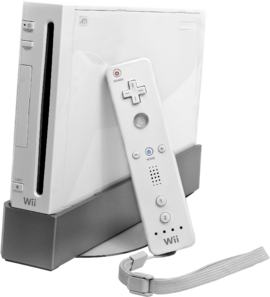 The first version of the Wii | |
| Generation | Seventh generation |
| Release date | Wii: Wii Family Edition: Wii mini: |
| Discontinued | Wii (Overall): Wii (Original): Wii Family Edition: Wii mini: 2017 |
| Predecessor | Nintendo GameCube |
| Successor | Wii U |
- “Wii would like to play”
- —Advertisement slogan for the Wii
The Wii is a home video game console created by Nintendo as the successor to the Nintendo GameCube. It was released in North America on November 19, 2006, for $249.99. It was then released in Japan on December 2, 2006; Oceania on December 7, 2006; and Turkey and Europe on December 8, 2006. Nintendo planned to release the system in China under the iQue name, but this ultimately did not happen. This is one of three Nintendo game consoles sold in North America before Japan, the others being the original Nintendo DS and the Wii U. Before the Wii's final name was announced on April 27, 2006, the console was codenamed "Revolution."
Like the Nintendo GameCube, the Wii uses proprietary optical discs based on the DVD format. Unlike with its predecessor, however, Wii game discs are a standard 12 cm (approx. 4.72 in.) in diameter rather than 8 cm (approx. 3.15 in.), which allows them to hold more memory than the GameCube discs: up to 4.37 GB for single-layered discs, and up to 7.92 GB for dual-layered discs. However, the Wii is backwards compatible with most Nintendo GameCube games, featuring four GameCube controller ports and two GameCube memory card slots on the top of the unit, making it the first Nintendo home console to be backwards compatible with its predecessor. The Wii lacks the GameCube's support for digital audio & video output, but it retains progressive scan support over component cables with compatible games (including all games related to the Super Mario franchise other than NBA Street V3 and WarioWare, Inc.: Mega Party Game$!). Under this configuration, the prompt to enable progressive scan automatically appears on startup (unlike with the GameCube, which required the player to hold ![]() during boot-up).
during boot-up).
The system had integrated Nintendo Wi-Fi Connection functionality, enabling players to interact with other players around the world while playing certain games, such as Mario Kart Wii.
Although the Nintendo GameCube was the first Nintendo home console since the Family Computer not to have a game from the Super Mario series at launch, the Wii is the first home console not to have a game from the Super Mario franchise as a launch title (except in Japan). The Wii's first Super Mario game is WarioWare: Smooth Moves, which came out on December 2, 2006, in Japan as a launch title; January 12, 2007, in Europe; January 15, 2007, in North America; and January 25, 2007, in Oceania. The first Super Mario game for the Wii starring Mario is Super Paper Mario, except in PAL regions, where Mario Strikers Charged was the game instead.
In 2012, the Wii was succeeded by the Wii U, which can still play Wii games and utilizes controllers with backwards compatibility.
Since May 20, 2014, the Nintendo Wi-Fi Connection service has shut down, discontinuing online play for games that used it.[8]
Revisions
Wii Family Edition
The Wii Family Edition (RVL-101) was announced on August 17, 2011. This model is designed to only sit horizontally (with the buttons changed accordingly) and is incompatible with the Nintendo GameCube's software and its accessories. This model was released in North America on October 23, 2011 and in Europe on November 4, 2011 in order to replace the older model and stop its production. The Wii Family Edition includes a black console, the game New Super Mario Bros. Wii, and the Super Mario Galaxy Original Soundtrack. The Wii Family Edition's release in North America was not originally intended to replace the older version of the Wii.[9]
Wii mini
The Wii mini (RVL-201)[10] was announced on November 27, 2012. As its name suggests, the Wii mini is the smallest model of the Wii. Like the Wii Family Edition, it is missing some features such as the compatibility with Nintendo GameCube and its accessories. It also does not have online features and several built-in channels, such as the Photo Channel and the Weather Channel, similar to the Wii Mode on the Wii U. It also can only sit horizontally. The main feature is its notable redesign. Unlike the original Wii or the Wii Family Edition which are mostly white, the Wii mini is black with a red framing. All the buttons are located on the top of the console, there are no SD card slots, and it lacks online support for Wii games. Additionally, the Wii mini has a manually operated top-loading disc drive (similar to the GameCube) instead of the slots that former models have. The console launched in Canada on December 7, 2012 for $99.99.[11] It was then released in Europe on March 22, 2013 at a cost of at least £79.99.[12] It was launched in North America on November 17, 2013 bundled with a red Wii Remote Plus and a red Nunchuk for $99.99.[13] The Wii mini is the third home Nintendo console since the SNES and NES to receive a redesign right after its respective successors launched though the NES 101 model launched 2 years after the SNES launched. The N64 received no redesigns of any kind, and the GameCube had a small revision that lacked the unused Serial Port 2 (though the cover still remains) and the unpopular Digital AV Out port.
Peripherals
Wii Remote
- NintendoWiki article: Wii Remote
The Wii Remote (also known as the "Wiimote") is the standard game controller for the Wii. It has a rectangular shape, resembling a television remote, making it unique from other consoles' controllers. It consists of several buttons (one behind (![]() )) and a directional pad (
)) and a directional pad (![]() ) as well. The Wii Remote also has a power button (
) as well. The Wii Remote also has a power button (), which can be used as a remote to either turn the Wii console on or off, rather than pressing the power button on the machine itself. When held horizontally, its button layout is similar to that of an NES controller, with the
![]() ,
, ![]() ,
, ![]() and
and ![]() buttons taking the functions of
buttons taking the functions of ,
,
and
, respectively; an example of this is New Super Mario Bros. Wii, mimicking the control scheme of the NES Super Mario platformers with the Wii Remote held sideways. The Wii Remote can be used for NES Virtual Console games but not for SNES and N64 Virtual Console games because the Wii Remote cannot be mapped to emulate an SNES or N64 controller properly.
Buttons
Wii Remote Plus
The Wii Remote Plus is an upgraded version of the Wii Remote, which includes the Wii MotionPlus attachment's system incorporated in the controller. The Wii Remote Plus was shown in the Nintendo's conference of September 2010, and is available in white, black, pink, cyan, and red colors. It was released in Europe on November 5, 2010 and in Japan on November 11, 2010.
Mario & Sonic at the Sochi 2014 Olympic Winter Games for the Wii U was the only game of the Super Mario franchise to ever use the Wii MotionPlus.
Nunchuk
- NintendoWiki article: Nunchuk
The Nunchuk is the main attachment to the Wii Remote. Upon buying a Wii, one Wii Remote and one Nunchuk are included. It consists of two buttons (![]() and
and ![]() ) along with an analog stick (
) along with an analog stick (![]() ). Like the Wii Remote, the Nunchuk also includes motion sensors. It is named as such because of the similarity in appearance to nunchaku when being used together with the Wii Remote.
). Like the Wii Remote, the Nunchuk also includes motion sensors. It is named as such because of the similarity in appearance to nunchaku when being used together with the Wii Remote.
- Names in other languages
| Language | Name | Meaning | Notes |
|---|---|---|---|
| Japanese | ヌンチャク[?] nunchaku |
Nunchuk | |
| Chinese (simplified) | 拿趣酷[14] Náqùkù |
Transliteration of Nunchuk, also means "To hold Fun and Cool" | |
| Chinese (traditional) | 雙截棍控制器[15] Shuāngjiégùn Kòngzhìqì |
Nunchuk Controller |
Buttons and Stick
- C (
 )
) - Z (
 )
) - Control Stick (
 )
)
Classic Controller
- NintendoWiki article: Classic Controller
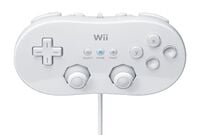
The Classic Controller is an extension or accessory for the Wii Remote. Besides the two analog sticks, the button layout resembles that of the Super Nintendo Entertainment System's controller. The Classic Controller must be used to play SNES and N64 Virtual Console games such as Super Mario World and Super Mario 64. Some Wii games, such as Super Smash Bros. Brawl and Mario Kart Wii are compatible as well.
Just as the Nintendo GameCube was codenamed Dolphin and the Wii was codenamed Revolution, the Classic Controller was codenamed Shell.[16]
Classic Controller Pro
- NintendoWiki article: Classic Controller Pro
The Classic Controller Pro is an enhanced version of the Classic Controller, listed on Nintendo's Japanese website on February 26, 2009. This revision features the ![]() and
and ![]() buttons as full-fledged shoulder buttons, like the
buttons as full-fledged shoulder buttons, like the ![]() and
and ![]() buttons on the Nintendo GameCube controller, as well as added controller grips. However, the
buttons on the Nintendo GameCube controller, as well as added controller grips. However, the ![]() and
and ![]() buttons are no longer pressure-sensitive, unlike with the original Classic Controller. The controller is also slightly bigger than its old revision. The Classic Controller Pro was released in Japan on August 1, 2009 in both black and white colors. It was subsequently released in Europe and North America in November 2009[17] and April 2010[18] respectively (though only in black in Europe).
buttons are no longer pressure-sensitive, unlike with the original Classic Controller. The controller is also slightly bigger than its old revision. The Classic Controller Pro was released in Japan on August 1, 2009 in both black and white colors. It was subsequently released in Europe and North America in November 2009[17] and April 2010[18] respectively (though only in black in Europe).
Buttons and Sticks
- a (
 )
) - b (
 )
) - y (
 )
) - x (
 )
) - +Control Pad (
 )
) - Left Control Stick (
)
- Right Control Stick (
)
- L (
 )
) - R (
 )
) - ZL (
 )
) - ZR (
 )
) - + (
 )
) - - (
 )
) - Home (
 )
)
Wii Balance Board
- NintendoWiki article: Wii Balance Board
The Wii Balance Board is a controller for the Wii that is used for various games, most prominently in Wii Fit. The Balance Board, unlike the Nunchuk or Classic Controller, acts as a separate controller and does not need to be connected to the Wii Remote. The Board is capable of measuring the weight, balance, and movement of the player that is using it. The only Super Mario game that ever used the Wii Balance Board was Mario & Sonic at the Olympic Winter Games. A costume of a Wii Balance Board appears in Super Mario Maker.
Wii Wheel
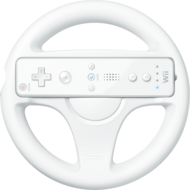
The Wii Wheel is an accessory for the Wii that resembles a car steering wheel and is designed for Mario Kart Wii. One Wii Wheel is packaged with Mario Kart Wii, but more can be bought separately. The Wii Wheel is used to assist in holding the remote and may help players control the game more easily. The Wii Wheel does not connect to the Wii or Remote in any way and is used to only hold the Remote. Because of this, if only the Wii Remote is held sideways (without the Wheel) on Mario Kart Wii, it still shows that a wheel is being used.
Prototypes
The first prototype was made when Nintendo was trying to discover the best position to put the Wii Remote. Since Nintendo could not decide where the ![]() button would be used, there was nothing on the back. For the second prototype, Nintendo examined real go-kart wheels, and the company discovered that they are usually more square than round. The third prototype was the basis for the final Wii Wheel. This prototype had a window for using the Wii Menu and a hole for the
button would be used, there was nothing on the back. For the second prototype, Nintendo examined real go-kart wheels, and the company discovered that they are usually more square than round. The third prototype was the basis for the final Wii Wheel. This prototype had a window for using the Wii Menu and a hole for the ![]() button. The fourth prototype had a
button. The fourth prototype had a ![]() button in the Wii Wheel itself, so a child’s finger could reach. Finally, the fifth prototype had a two-tone color scheme. A pure white color scheme was eventually decided on to match the Wii Zapper and the Wii Balance Board. Kenichiro Ashida made two Wii Wheels to show at the "Iwata Asks" interview on Mario Kart Wii.
button in the Wii Wheel itself, so a child’s finger could reach. Finally, the fifth prototype had a two-tone color scheme. A pure white color scheme was eventually decided on to match the Wii Zapper and the Wii Balance Board. Kenichiro Ashida made two Wii Wheels to show at the "Iwata Asks" interview on Mario Kart Wii.
Gallery
The Gold Wheel was available only as a redeemable prize from Club Nintendo in Australia, Europe, Japan, and North America.
Nintendo GameCube Controller
- Main article: Nintendo GameCube § Nintendo GameCube Controller
The Nintendo GameCube Controller can also be used for certain games such as Mario Kart Wii and Virtual Console games, and as an alternative to the Wii Classic Controller (and the Pro version).
SD cards
An SD card is a standardized memory card format supported by the Wii, which can be used to store WiiWare and Virtual Console games, some games and channels' photos, and to keep backups of certain games' save files. Far from all games allow the internal memory's save files to be moved to SD cards, and ones that do not support it include Mario Kart Wii, Super Smash Bros. Brawl and all GameCube games. Among Super Mario games that do support taking backups of save files, the files are typically small and around one block (128 KB), with a handful of Mario games at two blocks (256 KB) such as Mario Super Sluggers and Donkey Kong Country Returns.
At launch, the Wii only supported the initial industry standard that had a cap at 2 GB. The Wii System Menu 4.0 update in March 2009 added support for SDHC cards up to 32 GB, but it did not have retroactive effect for games released before then. The 4.0 update also added a designated SD card game menu that could launch WiiWare and Virtual Console games directly from the SD card, including from write-protected SD cards.
By inserting the Wii's SD card into a PC that has an SD card reader, JPEG images can be added to the SD card which can then be inserted back into the Wii to make them able to view in Photo Channel.
The Wii retained the GameCube's use of blocks as a non-standard data measurement unit, but the Wii's blocks are 128 KB, while those on GameCube were merely 8 KB. At full capacity, a 32 GB SC card would be converted internally by the Wii as 262,144 blocks.
Channel and WiiWare game sizes
Below is a list of the file sizes of Wii channels and WiiWare games that can be copied in their entirety to an SD card normally in the Data Management settings.
| Game | Blocks | Megabytes (MB) |
|---|---|---|
| Mario Kart Channel | 86 | 11.0 |
| Dr. Mario Online Rx | 103 | 12.8 |
| WarioWare: D.I.Y. Showcase | 50 | 6.2 |
Wii Message Board
The Wii Message Board, powered by WiiConnect24, was a messaging system that users could use to send messages to other Wii users prior to its discontinuation. The user could either register a different Wii Friend Code separate from the games that use Friend Code exchange or send a friend request to someone that uses a third-party e-mail service, such as Hotmail or Gmail. The service was discontinued on June 27, 2013.[19] Super Mario Galaxy, Super Mario Galaxy 2, and Mario Kart Wii use this feature separately from WiiConnect24.
In Super Mario Galaxy, the Mailtoad will send images to the Wii Message Board if both Mario and Luigi talk to him in the mission The Star Festival.
In Mario Kart Wii, a picture of the playable Mario, Peach, and the player's Mii before the player gets all gold on all courses or a picture of all the playable characters with the player's Mii after the player gets all gold is sent to the Wii Message Board upon the player finishing the credits.
In Super Mario Galaxy 2, a picture is obtained when the player beats Bowser one time and another once the player beats the game 100%.
- NintendoWiki article: Wii Channel
The Wii is Nintendo's first home console with a wide variety of built-in software. Wii Channels are channels accessible from the Wii Menu. There are four pages of channels; each page can hold twelve channels, meaning there can be in total 48 channels in a typical Wii Menu. The channels can be moved around on the Wii Menu by holding ![]() +
+ ![]() and dragging them.
and dragging them.
Disc Channel
- NintendoWiki article: Disc Channel
The Disc Channel is the channel in which game discs are loaded and played. It is the first channel on the menu and cannot be moved. It displays a preview icon of the game currently inside the disc slot and plays a unique jingle when selected; if a Nintendo GameCube game is in the slot, it does not have a preview and only displays the Nintendo GameCube logo and plays the default GameCube startup jingle when selected. When a disc is loading, as seen in the picture, the Nintendo GameCube and Wii discs are shown spinning, and whichever disc type that was inserted will lower into an opening denoting a disc reader.
- Names in other languages
| Language | Name | Meaning | Notes |
|---|---|---|---|
| Spanish | Canal Disco[?] | Disc Channel |
Mii Channel
- MiiWiki article: Mii Channel
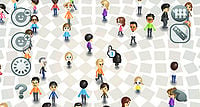
Miis are customized characters that can be used in various Wii games, including games such as Mario Party 8, Mario Kart Wii and the Mario & Sonic games. A maximum of 100 Miis can be created and saved in the Mii Channel in the Mii Plaza. By using WiiConnect24, friends' Miis can be displayed in the Mii Parade; a parade of various Miis saved on friends' Mii Channels. Miis can also be stored in Wii Remotes, with a maximum capacity of 10. These Miis can then be transported to a different Wii by using the Wii Remote on a different Wii and then loading the Miis from the controller. The option to transfer Miis to a supporting Nintendo 3DS system can be unlocked by pressing ![]() ,
, ![]() ,
, ![]() , and
, and ![]() in that order.[20]
in that order.[20]
- Names in other languages
| Language | Name | Meaning | Notes |
|---|---|---|---|
| Spanish | Canal Mii[?] | Mii Channel |
Photo Channel
- NintendoWiki article: Photo Channel
The Photo Channel allows the user to save, view, and apply various effects to photos and videos from either an SD card or the Wii Message Board. Effects include doodling, stamping, and altering brightness settings. Photos can also be turned into sliding puzzles. When the game Mario Kart Wii is beaten, the player is given the choice whether or not to send the winning photo to the Message Board. There are several other games that behave like this such as Super Mario Galaxy and Super Mario Galaxy 2.
- Names in other languages
| Language | Name | Meaning | Notes |
|---|---|---|---|
| Spanish | Canal Fotos[?] | Photos Channel |
Wii Shop Channel
- NintendoWiki article: Wii Shop Channel
The Wii Shop Channel was a virtual shopping network where users could purchase and download WiiWare and Virtual Console games in exchange for the required amount of Wii Points. The Virtual Console allowed players to download games that were originally released on the NES, SNES, and Nintendo 64, and play them on their Wii console. They could also buy special games called WiiWare which can be purchased only on the Wii Shop Channel itself. Rather than using money to directly buy the games, a credit currency called Wii Points is used. Wii Points can be earned by either purchasing them with a credit card or redeeming a Wii Point Card. Other free-of-charge channels, such as the Nintendo Channel and Internet Channel, were also available for download at the Wii Shop Channel.
When downloading a game or channel from the Wii Shop Channel, one would be asked to verify their purchase (if Wii Points are needed), after which they will be presented with the download screen. The download screen consisted of an 8-bit Mario character continuously running across the bottom of the screen and collecting coins as they moved towards him. The progress of the download was indicated by three Brick Blocks floating above 8-bit Mario's head, which he will jump up and hit as he runs across the screen. Every time the download progresses 33%, a Brick Block would have turned into an Empty Block. The final Brick Block represents the point at which the download has reached 99%. When 8-bit Mario reaches this block, he would jump and hit it multiple times and continue to do so until the download was complete.
Sometimes, Fire Mario would have appeared instead of regular Mario. When this happens, one could have made Fire Mario shoot fireballs while the download was in progress by pressing the ![]() button. Occasionally, 8-bit Luigi appears in place of 8-bit Mario, or both 8-bit Mario and 8-bit Luigi would swim across the screen instead of running across it. There is a total of six different animations one may have experienced while downloading software from the Wii Shop Channel, some of which appear more often than others.
button. Occasionally, 8-bit Luigi appears in place of 8-bit Mario, or both 8-bit Mario and 8-bit Luigi would swim across the screen instead of running across it. There is a total of six different animations one may have experienced while downloading software from the Wii Shop Channel, some of which appear more often than others.
The Wii Shop Channel service was discontinued on January 30, 2019, though the ability to add Wii Points was discontinued on March 26, 2018. Between these times, users would have still been able to browse and download purchased software.[21]
The Nintendo 3DS, Wii U, and Nintendo Switch have a similar online shop called the Nintendo eShop. The Nintendo DSi also had an online shop (simply called the Nintendo DSi Shop), but that shop was also discontinued.
8-bit Mario appearing on the Wii Shop Channel download screen
- Names in other languages
| Language | Name | Meaning | Notes |
|---|---|---|---|
| Spanish | Canal Tienda Wii[?] | Wii Shop Channel |
Forecast Channel
- NintendoWiki article: Forecast Channel
The Forecast Channel was added on December 19, 2006, about one month after the console itself was released. The channel preview displayed the local weather of where the user is located. Some games, including Mario & Sonic at the Olympic Winter Games, have an option that allowed the game to draw information from the Forecast Channel and use that weather as the weather conditions in the game.
- Names in other languages
| Language | Name | Meaning | Notes |
|---|---|---|---|
| Spanish | Canal Tiempo[?] | Weather Channel |
Virtual Console Channels
Virtual Console channels are downloadable games that can be purchased from the Wii Shop Channel at varying prices. These various channels allow users to play classic NES, SNES, and Nintendo 64 games such as Donkey Kong, Super Mario World, and Super Mario 64. The Virtual Console also supports selected games from the Sega Genesis/Mega Drive and the TurboGrafx-16 systems. Although some games can be played using the Wii Remote, others require the use of either a Nintendo GameCube controller or a Classic Controller.
Nintendo Channel
It has been requested that this section be rewritten and expanded to include more information. Reason: Which Super Mario demos, to be exact?
- NintendoWiki article: Nintendo Channel
The Nintendo Channel was released in November 2007 in Japan and May 7, 2008 in America. The Nintendo Channel allows players to view video features and information on upcoming games, including those in the Super Mario franchise. After downloading, the demos will remain in the DS's memory until the system is switched off. Users could also recommend games that they have played for more than an hour by filling out a brief survey that asks which demographic it is best suited for. Other features include Nintendo DS and Wii demonstration videos, with gameplay videos of newly released Virtual Console and future WiiWare titles. If a game sparks the player's interest, they will be quickly directed to one of several popular purchasing sites via the Internet Channel. The Nintendo Channel was removed along with WiiConnect24.
- Names in other languages
| Language | Name | Meaning | Notes |
|---|---|---|---|
| Spanish | Canal Nintendo[?] | Nintendo Channel |
Mario Kart Channel
The Mario Kart Channel is a channel specifically made to work with Mario Kart Wii. The channel requires 86 blocks (11.0 MB) to be installed. Once installed from the game, this channel can be used to register friends, race ghosts, race friends or random users, enter tournaments, and get updates from Nintendo or other players. The Nintendo 3DS game Mario Kart 7 also includes Mario Kart Channel as an in-game mode, though it has different features.
- Names in other languages
| Language | Name | Meaning | Notes |
|---|---|---|---|
| Chinese (traditional) | 瑪利歐賽車頻道[22] Mǎlì'ōu Sàichē Píndào |
Mario Kart Channel | |
| Spanish | Canal Mario Kart[?] | Mario Kart Channel |
WiiWare channels
- Main article: WiiWare
WiiWare was a feature that was launched for the Wii Shop Channel in 2008, which consisted of smaller-sized games that could be downloaded onto the Wii or SD card memory using Wii Points, which would then appear on the Wii Menu as individual channels. Some Super Mario WiiWare titles included Dr. Mario Online Rx and WarioWare: D.I.Y. Showcase. Some WiiWare titles used Nintendo Wi-Fi connection, allowing the player to play with other Wii players over the internet. Others included Mii compatibility, allowing players to play the game as their own Mii created in the Mii Channel. Also, some games allowed the player to transfer and use the data from a Nintendo DS game, such as WarioWare D.I.Y. Showcase.
Virtual Console
- Main article: Virtual Console
In addition to being backwards-compatible with Nintendo GameCube games, the Wii Shop Channel has a section called Virtual Console, which allows the players to download emulated versions of games from the Nintendo 64 era and before to play on the Wii. Many of them were Super Mario games. Each downloaded game costs between 500 and 1000 Wii Points. The games are priced based on the system they were released on, with imported games generally costing an additional 100 points, or 200 points for Nintendo 64 games.
The Virtual Console versions of games are primarily straight emulations with no major changes or additions, although a few games such as Super Mario RPG: Legend of the Seven Stars and Mario Kart 64 are edited to remove potentially seizure-inducing or copyright-infringing graphics. Additionally, Nintendo 64 games do not support the Rumble Pak or Transfer Pak accessories, meaning parts of games that use these features may not function completely in the Virtual Console version.
The Wii Virtual Console is also accessible from the Wii U inside Wii mode, independently from the Wii U's own Virtual Console.
Appearances in the Super Mario franchise
WarioWare series
WarioWare: Smooth Moves
The Wii Remote (known as the Form Baton in the game) appears in several microgames in WarioWare: Smooth Moves, as well as an object in the game's story. The Nunchuk (known as the Balance Stone in the game) appears in Orbulon's microgames and story.
WarioWare: D.I.Y.
In the intro cutscene of WarioWare: D.I.Y., Dr. Crygor is playing a Wii game, as the console is seen near the TV.
WarioWare Gold
The Wii appears as a collectible Nintendo souvenir in WarioWare Gold.
WarioWare: Get It Together!
In 9-Volt's Nintendo Classics level in WarioWare: Get It Together!, the boss that appears in the intermission before the boss microgame wields a Wii Remote as a sword.
Super Paper Mario
When the player enters Francis's room in Fort Francis and flips, they can see a large TV and a Wii with a Wii Remote. Also, when the player fights Fracktail, Fracktail starts downloading information about Mario. While he is doing so, his eyes turn into the circle that appears when the Wii Shop Channel is loading from the Wii Menu.
Mario Kart Wii
In the cutscene before the file selection screen, Mario and Luigi use Wii Wheels to race and drive in invisible karts. Peach joins them with her own Wii Wheel, and their karts become visible shortly afterwards, with their Wii Wheels becoming their karts wheels.
Mario Super Sluggers

In the opening cinematic of Mario Super Sluggers, Daisy, Luigi, and Mario carry Wii Remotes with them as they run towards Mario Stadium. When Daisy brandishes the remote on the mound, it transforms into a baseball bat, and Luigi encounters the same method moments later. When Mario brandishes the remote, it transforms into a baseball.
Yoshi's Woolly World
Although the console itself does not appear in Yoshi's Woolly World, a Yoshi design based off the Wii can be unlocked in World 2-S: Perils of the Perplexing Pyramid.
Super Smash Bros. series
Starting with Super Smash Bros. for Nintendo 3DS, Wii Fit Trainer's entrance animation has them balancing on a Wii Balance Board before stepping off of it. In addition, the Wii Balance Board appears as a trophy in Super Smash Bros. for Wii U. The Wii Balance Board also appears as a master spirit in Super Smash Bros. Ultimate, teaching the Lightweight Style to other spirits (said style increases move speed and jump height, but decreases offense, defense, and weight). The Wii Balance Board spirit battle is against Wii Fit Trainer on the Wii Fit Studio stage with the music "Wii Fit Plus Medley" (from Wii Fit Plus) playing, with all fighters having increased movement speed and being easier to launch after some time.
Mario & Luigi: Superstar Saga + Bowser's Minions
In Mario & Luigi: Superstar Saga + Bowser's Minions, a Wii Wheel is found hanging on the wall in the Mario Bros.' House.
Galleries
System gallery
Black Wii bundle also consisting of New Super Mario Bros. Wii and the Super Mario Galaxy Original Soundtrack album
Wii's special red edition commemorating the 25th anniversary of the Super Mario franchise which comes with New Super Mario Bros. Wii
The Wii icon used to promote Super Mario 3D All-Stars
Accessory and controller gallery
Wario holding a Wii Remote for Wario Land: Shake It!
A Toad Wii Remote
A Bowser Wii Remote
A Peach-themed Wii Wheel
A Metal Mario-themed Wii Wheel
Game gallery
Miscellaneous
Media
- For a complete list of media for this subject, see List of Wii media.
| File info |
| File info |
| File info |
| File info |
Names in other languages
| Language | Name | Meaning | Notes |
|---|---|---|---|
| Japanese | ウィー[?] Wī |
Wii |
Trivia
- Due to the Virtual Console service and GameCube backwards compatibility, seven Mario Party titles are playable on the Wii, more than any other console to date.
- Despite the system being released in Taiwan and Hong Kong and games being localized in Traditional Chinese, the Wii system software was never officially localized in Traditional Chinese; models released in those territories use Japanese as the system software language instead.
References
- ^ December 18, 2006. Nintendo Wii TrendShow'da. Hürriyet (Turkish). Retrieved July 3, 2024. (Archived March 18, 2019, 16:00:48 UTC via Wayback Machine.)
- ^ December 18, 2006. Nintendo-Erfolg beschert Spielwarenspezialist Stadlbauer Umsatzplus. Der Standard (German). Retrieved June 4, 2024. (Archived via archive.today.)
- ^ September 28, 2007. Nintendo Wii launches in South Africa. IOL (English). Retrieved May 31, 2024.
- ^ March 26, 2008. La Wii inaugura en Argentina la era de las consolas de última generación. CanalAR (Spanish). Retrieved July 13, 2024.
- ^ Akfamilyhome (April 1, 2020). A History of Nintendo's Hong Kong Releases. YouTube (Cantonese & English (English subtitles available)). Retrieved June 5, 2024. (Archived May 25, 2024, 11:22:53 UTC via Wayback Machine.)
- ^ Bonamin, Kadu (October 20, 2013). Reino do Cogumelo (Spanish). Retrieved May 31, 2024.
- ^ East, Thomas. Wii has been discontinued in Europe but you can still buy a Wii Mini. Official Nintendo Magazine (British English). Archived October 28, 2013, 02:30:21 UTC from the original via Wayback Machine. Retrieved May 31, 2024.
- ^ Makuch, Eddie (February 27, 2014). Nintendo killing online support for Mario Kart Wii, Super Smash Bros. Brawl in May. GameSpot (English). Retrieved May 31, 2024.
- ^ Brian (October 11, 2011). Black Wii Holiday Bundle with New Super Mario Bros. Wii and Exclusive Music CD Arriving Oct. 23. Nintendo Everything. Retrieved May 31, 2024.
- ^ Nintendo Wii UK (May 7, 2013). Wii mini and Nintendo Selects - Launch Trailer (Wii). YouTube (British English). Retrieved May 31, 2024.
- ^ November 22, 2012. NINTENDO INTRODUCES NEW Wii MINI THAT'S ALL ABOUT THE GAMES. Nintendo of America (American English). Archived November 29, 2012, 19:01:55 UTC from the original via Wayback Machine. Retrieved May 31, 2024.
- ^ February 26, 2013. New Wii mini console launching on 22nd March. Nintendo UK. Retrieved May 31, 2024.
- ^ November 4, 2013. Wii mini Offers Big Value This Holiday Season. Nintendo of America (American English). Archived November 4, 2013, 21:31:31 UTC from the original via Wayback Machine. Retrieved May 31, 2024.
- ^ From the unused Simplified Chinese Wii System Menu text
- ^ Wii主機. Nintendo HK (Traditional Chinese). Retrieved May 31, 2024.
- ^ Gibson, Ellie (September 19, 2005). Jim Merrick Takes Control. Eurogamer (English). Retrieved May 31, 2024.
- ^ Siliconera Staff (October 20, 2009). Black Wii Bundle, Classic Controller Pro Dated For Europe. Siliconera. Retrieved May 31, 2024.
- ^ Davies, Chris (January 25, 2010). Wii Classic Controller Pro Hits US From April 2010. SlashGear. Retrieved May 31, 2024.
- ^ April 12, 2013. Shutdown of Wii Channels. Nintendo of America (American English). Archived April 14, 2013, 03:58:26 UTC from the original via Wayback Machine. Retrieved May 31, 2024.
- ^ How to Transfer Miis to 3DS (or Transfer Miis from the Wii to the 3DS). GameYum. Retrieved May 31, 2024.
- ^ Romano, Sal (September 29, 2017). Wii Shop Channel to end service on January 31, 2019. Gematsu. Retrieved May 31, 2024.
- ^ 瑪利歐賽車 Wii (日文版):遊戯模式 - 台灣任天堂網站. Nintendo Taiwan (Traditional Chinese). Retrieved May 31, 2024.
| Video game systems and add-ons | |
|---|---|
| Nintendo home consoles | Family Computer/Nintendo Entertainment System (Family BASIC, Family Computer Disk System) • Super Famicom/Super Nintendo Entertainment System (Satellaview, Super Game Boy) • Nintendo 64 (Nintendo 64DD) • Nintendo GameCube (Game Boy Player) • Wii (Virtual Console, WiiWare) • Wii U (Virtual Console) • Nintendo Switch |
| Nintendo handhelds | Game & Watch • Game Boy • Virtual Boy • Game Boy Color • Game Boy Advance • Nintendo DS (Nintendo DSi, DSiWare) • Nintendo 3DS (Virtual Console) • Nintendo Switch |
| Other | MS-DOS • VS. System • Nintendo PlayChoice-10 • Nintendo Super System • Nelsonic Game Watch • Super Mario Bros. Watch • Gamewatch Boy • Philips CD-i • Mini Classics • Triforce • Visteon Dockable Entertainment System • Classics • LodgeNet • Nintendo Sound Clock: Alarmo |

